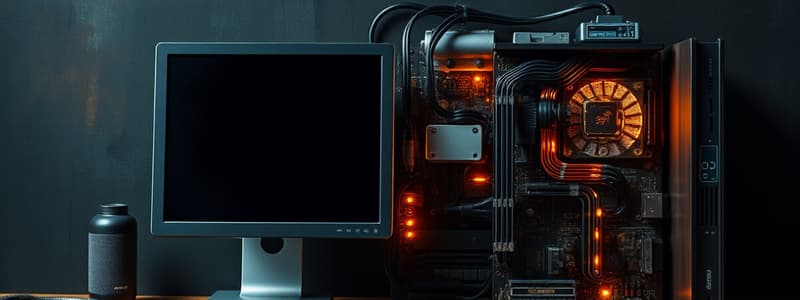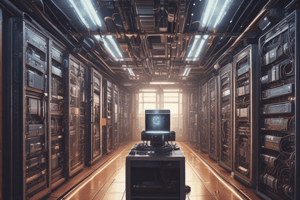Podcast
Questions and Answers
What is the primary role of a microprocessor in a computer system?
What is the primary role of a microprocessor in a computer system?
The microprocessor acts as the brain of the computer, executing instructions and processing data.
How do storage devices differ from memory in terms of speed and capacity?
How do storage devices differ from memory in terms of speed and capacity?
Storage devices are much slower than memory but have a significantly larger capacity for long-term data storage.
Can you name two examples of input devices and describe their functions?
Can you name two examples of input devices and describe their functions?
Examples of input devices include a keyboard, which allows users to enter text, and a mouse, which enables point-and-click navigation.
What is the function of buses in a computer architecture?
What is the function of buses in a computer architecture?
Describe the role of operating systems in managing computer resources.
Describe the role of operating systems in managing computer resources.
What are System on Chip (SoC) architectures, and why are they significant?
What are System on Chip (SoC) architectures, and why are they significant?
How do output devices interact with the CPU?
How do output devices interact with the CPU?
Explain why chip-based memory is essential for a computer system.
Explain why chip-based memory is essential for a computer system.
What are the primary functions of a CPU?
What are the primary functions of a CPU?
Explain the role of the Control Unit in a CPU.
Explain the role of the Control Unit in a CPU.
How does the ALU contribute to the CPU's functionality?
How does the ALU contribute to the CPU's functionality?
What is the significance of cache memory in a CPU?
What is the significance of cache memory in a CPU?
Define System on Chip (SoC) and its relevance to modern CPUs.
Define System on Chip (SoC) and its relevance to modern CPUs.
How does a multi-core CPU differ from a single-core CPU?
How does a multi-core CPU differ from a single-core CPU?
What impact do operating systems have on CPU performance?
What impact do operating systems have on CPU performance?
Describe the relationship between input devices, the CPU, and output devices.
Describe the relationship between input devices, the CPU, and output devices.
What is the primary advantage of Hyper-Threading in CPU performance?
What is the primary advantage of Hyper-Threading in CPU performance?
How does a System on Chip (SoC) differ from traditional motherboard-based PC architecture?
How does a System on Chip (SoC) differ from traditional motherboard-based PC architecture?
Why might actual multiple CPU cores be considered more efficient than virtual cores?
Why might actual multiple CPU cores be considered more efficient than virtual cores?
Give an example of how Hyper-Threading can be compared to a fast-food service.
Give an example of how Hyper-Threading can be compared to a fast-food service.
What role does the operating system play in relation to Hyper-Threading?
What role does the operating system play in relation to Hyper-Threading?
What components are typically integrated into a System on Chip (SoC)?
What components are typically integrated into a System on Chip (SoC)?
What happens when both virtual cores in Hyper-Threading require maximum access to execution resources?
What happens when both virtual cores in Hyper-Threading require maximum access to execution resources?
In what scenario is Hyper-Threading more beneficial, and why?
In what scenario is Hyper-Threading more beneficial, and why?
Flashcards are hidden until you start studying
Study Notes
Computer Architecture Overview
- A typical desktop computer consists of modular components, allowing for easy upgrades and replacements.
- Primary components include the Microprocessor (CPU), Memory, Storage devices, Input devices, Output devices, and Buses.
Component Functions
- Input Devices: Allow users to enter data (e.g., keyboard, mouse, scanner).
- Output Devices: Produce outputs from CPU data (e.g., monitor, printer).
- Buses: Physical connections for data transfer, can be integrated into the motherboard or external cables (e.g., IDE, ATA).
- Memory: Fast chip-based storage that holds binary instructions, calculation results, and provides data to the CPU.
- Storage Devices: Slow but large capacity systems for long-term data storage (e.g., floppy drives, HDDs, CD/DVD).
- CPU: Acts as the "brain," manages information flow, communications with memory and I/O devices, and performs computations.
Central Processing Unit (CPU)
- Speed is measured in MHz or GHz; notable models as of 2019 include:
- Intel i9: 8 cores, 16 threads
- Intel Xeon D: 18 cores, 36 threads
- AMD RYZEN Threadripper 2: 32 cores, 64 threads
- Comprised of four sections:
- Control Unit: Regulates information flow.
- ALU (Arithmetic Logic Unit): Handles logic and calculations.
- Registers: Fast storage for instructions and data.
- Cache (L1 and L2): Stores frequently accessed data; L1 is primary and L2 secondary.
Modern CPU Architecture
- Multi-core CPUs allow for parallel processing, where each core functions independently with its own components, supporting multitasking.
- Hyper-Threading: Intel’s technology that simulates two logical processors per physical core to optimize resource use, improving processing speed when one core is resource-stalled.
System on Chip (SoC)
- SoCs integrate various components of traditional PC architecture into a single chip, simplifying design and improving efficiency compared to conventional architectures that use separate components.
Studying That Suits You
Use AI to generate personalized quizzes and flashcards to suit your learning preferences.




